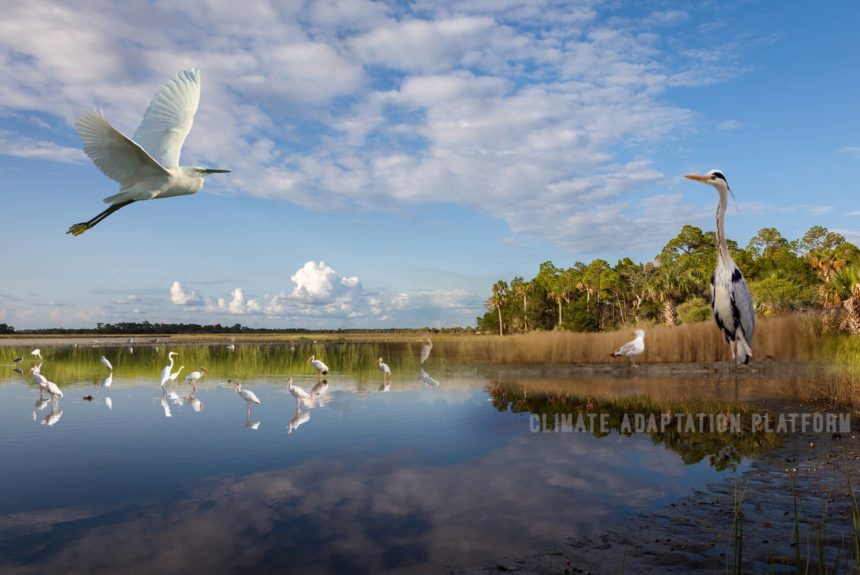Coastal wetlands, such as salt marshes, mangrove forests, seagrass meadows, mangrove swamps, and shrubby depressions, are known for their capacity to sequester vast amounts of carbon from water, storing it in their branches, leaves, roots, and deep within the soil.
These carbon soils are called “blue carbon” because they are found where the land meets the sea.
Besides capturing carbon, coastal wetlands offer many benefits, such as protecting and stabilising coastlines against storm surges and excess floodwaters, making communities resilient to climate-related threats.
Coastal wetlands also promote healthy ecosystems and aquatic life, providing food and livelihoods to the community.
The Pew Charitable Trusts article, “Coastal ‘Blue Carbon’: An Important Tool for Combating Climate Change, ” says coastal wetlands are critical carbon sinks worldwide. The article mentions:
- Although they occupy 5% of the global land area and less than 2% of the ocean, they store around 50% of all carbon buried in ocean sediments.
- Healthy coastal wetlands can store carbon for up to thousands of years.
- However, these key carbon sinks are also shrinking and at risk of degrading. When these wetlands are degraded, vast amounts of GHG gases, such as methane, carbon dioxide, and nitrous oxide, can be released into the atmosphere, contributing to climate change.
- An estimated 450 million metric tons of CO2, equivalent to more than 97 million cars, are emitted due to the destruction of coastal wetlands every year around the world.
The United Nations Framework Convention on Climate Change (UNFCCC) has recognised the significant contribution of coastal wetlands to climate adaptation and mitigation. It is the only marine ecosystem for which the Intergovernmental Panel on Climate Change (IPCC) has developed methodologies to measure carbon dynamics and conducts research supporting the UNFCCC.
The PEW article enumerates the critical ecosystem services of coastal wetlands – salt marshes, seagrasses, and mangroves- and why we must expand and protect them. Its many benefits include: absorbing millions of gallons of floodwater, reducing pollutants into coastal waterways, serving as essential habitat for fisheries, sequestering massive amounts of carbon and organic carbon from the oceans, and providing food like crabs, fish, shrimps, etc., to the community.
Protecting coastal wetlands can complement global efforts to curb emissions, yet these blue carbon ecosystems are shrinking. Since 1970, 35% of coastal wetlands have been destroyed. Some have been converted to agricultural use, destroyed by coastal development, pollution, and human activities.
Since the United Nations’ IPCC first recognised the coastal wetland’s important role in preventing climate change in 2013, efforts to protect these key carbon sinks have grown worldwide.
The Environmental Protection Agency (EPA) has included coastal wetlands in its annual US Greenhouse Gas Emissions and Sinks Inventory. Since re-joining the Paris Agreement in 2021, they have used the EPA’s carbon sequestration inventory as leverage to meet the treaty’s requirements.
Many coastal states have adopted GHG reduction goals and plans, incorporated strategies to enhance carbon sequestration, and set their coastal wetlands conservation and restoration targets.
The article mentions the state of Oregon as it develops its first blue carbon strategy. The state has developed its first-ever blue carbon inventory and strategy for maintaining and enhancing carbon storage in its estuaries.
As nations around the world recognise the potential role of coastal habitats in preventing and fighting climate change and meeting GHG reduction targets, the article urges Governments to use targeted policy mechanisms such as the Nationally Determined Contributions (NDCs) under the Paris Agreement to incorporate and boost the protection and conservation of these blue carbon ecosystems.
Two studies from Australia investigated carbon stocks within the blue carbon ecosystems across the Victorian coastline (southeast Australia). The study is among the first to present a comprehensive comparison of sediment stocks across and within coastal blue carbon ecosystems and has found that these ecosystems serve as dense carbon sinks that are crucial for reducing GHG gas concentration.
However, due to land use and reclamation, valuable carbon stock stored for thousands of years has been lost. The study says that these blue carbon ecosystems would need protection in the future if they were to maintain their role as carbon sinks.
To read these studies, click the links below:
Sources:
Coastal ‘Blue Carbon’: An Important Tool for Combating Climate Change. (2021, September 20). PEW. Retrieved from https://www.pewtrusts.org/en/research-and-analysis/issue-briefs/2021/09/coastal-blue-carbon-an-important-tool-for-combating-climate-change
Wetland Carbon. Blue Carbon Lab. Retrieved from https://www.bluecarbonlab.org/wetland-carbon/
What are Coastal Wetlands? Science & Climate. Retrieved from https://climatechange.ucdavis.edu/climate-change-definitions/coastal-wetlands/



Leave a Reply